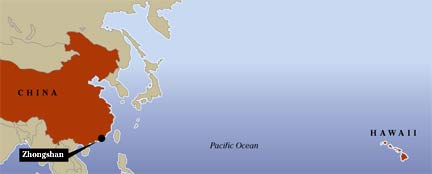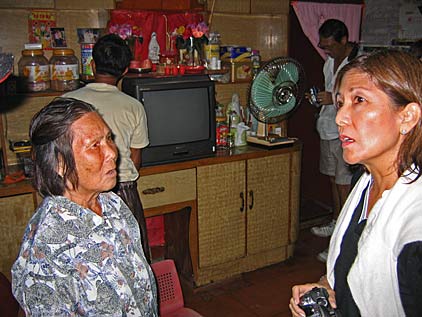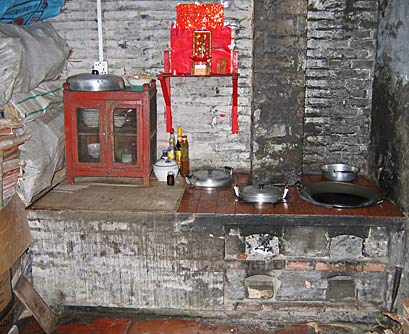LINKED TO ZHONGSHAN

A statue in southern China's Zhongshan county depicts a Chinese elder counseling a young Sun Yat-sen in front of the Chinese revolutionary leader's home.
Hawaii’s Roots
Immigrants' descendants return
to their ancestral homes
|
ZHONGSHAN COUNTY, China » Nearly everyone who comes back to Zhongshan gets that "chills" moment.
For Patsy Dung, it came last week when she walked into a house she had never seen before, more than 5,000 miles from her Honolulu home, and noticed a woman's picture on the wall.
"I couldn't believe it. I said, 'That's my popo (grandmother)!'" Dung said.
The house was the ancestral home of her mother's side, and Dung's visit marked the culmination of a personal pilgrimage made again and again each year by Hawaii Chinese.
Zhongshan County is about an hour by ferry from Hong Kong and, on the surface, an unremarkable stretch of rolling hills smothered in damp green forest.
The landscape is dotted by the occasional village full of narrow brick and cement houses packed together so tight that each village looks like one large organism.
But in those homes were born the restless souls who radiated out to the world beginning in the late 19th century. Areas like Zhongshan are the main reason that the Cantonese language and cuisine provide the sounds and smells of Chinatowns around the world.
The migration changed the face of Hawaii, accounting for anywhere from 70 percent to 90 percent -- depending on whom you ask -- of the Chinese descendants living in the islands.
"Of course we're very proud of that. Those people were very brave," said Lin Yu, an official with the Zhongshan Overseas Chinese Affairs Bureau.
Drawing no distinction between those who migrated and those who visit today, he adds, "And we are happy to welcome them back today."
And come they do. Local officials have no firm statistics on just how many Chinese from Hawaii or elsewhere return each year.
But the fact that there is an Overseas Chinese Affairs Bureau -- a rarity for a county government -- says something.
"Roots" tourism, if it can be called that, is one of Zhongshan's biggest industries and the bureau, along with local tour guides, are expert at helping visitors track down hometowns they've never seen.
This is often accomplished with little more than a fragment of a long-gone relative's name.
"We can find anybody's home, but it might take a while," said Tim Ding, a local tour guide.

Au Fong, with her husband Marvin, was seeking the home in which her grandmother was born, now occupied by distant relatives whom she'd never met.
Ding had a head start. He knew roughly where to look, and an unflappable driver who fearlessly squeezed their mini-van through alleys barely wider than outstretched arms.
But it wasn't until after a number of false leads, tips from villagers, and a sudden driving rainstorm that a breakthrough occurred.
Villagers directed him to a group of people lounging on plastic chairs. One of them, a girl who turned out to be related to Au Fong, piped up and said she knew the house.
Three hours after the search began, Au Fong stepped into an Spartan red-brick home, perfumed by burning incense, built more than 100 years ago by her great-grandfather.
"It's indescribable," she said. "Everyone should do this and find out where they came from."
Returnees like her are vital to the local economy.

Sandra Au Fong listens through an interpreter as distant relative Bao Yueqing, 73, inquires about family members who emigrated to Hawaii decades ago. The pair met last week in the southern Chinese village of Zhongshan, where Au Fong tracked down her ancestral home.
The effects are obvious. Unlike most areas of China, its roads and highways are top-notch, putting Honolulu's to shame.
Much of that income can be attributed to the most famous of Zhongshan's emigrees, Dr. Sun Yat-sen.
The county is, in fact, named after one of the late revolutionary leader's many aliases, and his former home here is a well-tended tourist attraction.
Dr. Sun's legacy provides another link between Zhongshan and Hawaii. It was in Hawaii that Sun completed his early schooling before returning to China, a fact cited time and again by Chinese officials during a Hawaii trade mission through China last week.

Relatives of Hawaii resident Sandra Au Fong still cook using a wood stove made of brick in the village of Zhongshan, ancestral home to most of Hawaii's Chinese.
But though the county is relatively prosperous for China, the distant relatives encountered by visitors from Hawaii live lives that are unimaginable to most returnees.
Au Fong's relatives, for example, cook using a wood-fired brick stove. There is no toilet or running water.
"Our parents lived in a little house and talked about how they really struggled, but it doesn't register until you physically go back there and see it," said Tommy Yim, a retired former state employee.
"So with what we earn here, we always set aside some to send back to China so they can buy a little better things. We know how tough the situation is back there," he said.
Of all the Zhongshan descendants in America, Hawaii's Chinese are perhaps the most dutiful.
Zhongshan travel agencies say Hawaii Chinese account for anywhere from 50 percent to 80 percent of the returnees.
Lin of the Zhongshan Overseas Chinese Affairs Bureau thinks he knows why.
"It might be that because Hawaii's Chinese people are closer to Zhongshan, they remain closer in their hearts too," he said.
E-mail to City Desk
[News] [Business] [Features] [Sports] [Editorial] [Do It Electric!]
[Classified Ads] [Search] [Subscribe] [Info] [Letter to Editor]
[Feedback]
